A tour hosted by Taylor Shellfish Farms as part of the SeaWeb Sustainable Seafood Summit provides insight into bivalve aquaculture, Washington-style
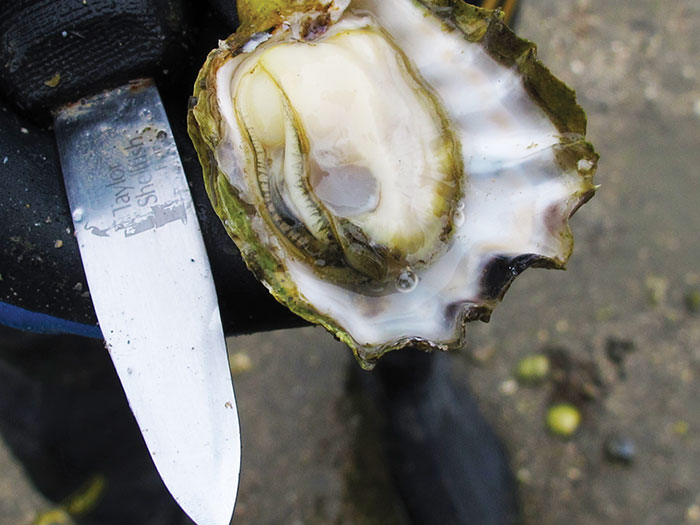 About 20 per cent of oysters are shucked and sold as meat. 2 Locally grown Blue Mussels prepared as part of a seafood lunch for the tour group.
About 20 per cent of oysters are shucked and sold as meat. 2 Locally grown Blue Mussels prepared as part of a seafood lunch for the tour group. Photos: Catherine Norwood
By Catherine Norwood
When you walk across the tidal flats at Totten Inlet on Washington’s Puget Sound, tread carefully: you are walking on next year’s crop of clams and oysters.
While the clams may be safely hidden beneath the mud, sand and gravel, various species of oysters sit openly on the beach where they have been deliberately seeded to grow in the ebb and flow of the tide. This includes Olympia Oysters and Pacific Oysters in sucessive seasons.
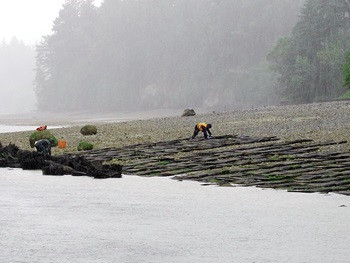 Young oysters are initially laid out in mesh bags, but once big enough will be left in the open in the beach tidal zone to grow to a harvestable size.
Young oysters are initially laid out in mesh bags, but once big enough will be left in the open in the beach tidal zone to grow to a harvestable size. When it is time for harvest, the oysters are simply shovelled off the surface into baskets and taken to the company’s processing plant for cleaning, grading and sometimes shucking.
This style of tidal production is one of four techniques Taylor Shellfish Farms uses for oysters at its five farm locations – four in Washington and one in the Canadian state of British Columbia. The other techniques include seeded ropes, a bag and buoy system and vertically hanging column baskets.
When the Taylor family first began farming in 1890, the small native Olympia Oyster (Ostrea lurida) was the focus of production. The California gold rush had created an insatiable appetite for oysters in San Francisco.
As luck would have it, however, Washington was too far north to regularly supply this market, which effectively prevented the overfishing of oyster stocks, as was the case further down the coast.
The Taylors are now in their fifth generation as shellfish farmers and Bill Taylor heads the operation with his brother and sister. Collectively they have eight children also involved. They have 732 employees, including those in Canada. This includes oyster bars in Seattle, Olympia and Shelton, two shellfish markets and hatcheries in Washington and California, in addition to their farming operations and two processing sites.
They still harvest Olympia Oysters, generally at three to four years old, but these now constitute less than two per cent of the 60 to 70 million oysters produced each year.
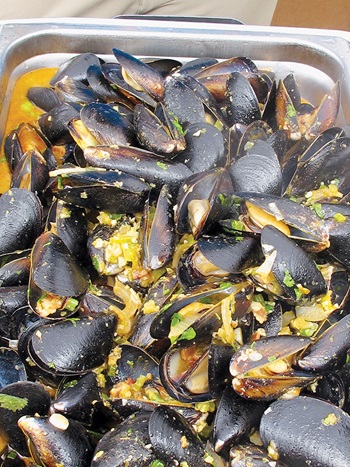 Locally grown Blue Mussels prepared as part of a seafood lunch for the tour group.
Locally grown Blue Mussels prepared as part of a seafood lunch for the tour group.Pacific Oysters (Crassostrea gigas) make up 90 per cent of production. Seed was first introduced from Japan in the 1920s, but has been locally produced since the 1970s. The Taylors use different production systems depending on the location and desired results – mostly triploid oysters, with some diploid, all produced in their own hatcheries.
Seeding onto ropes often results in clumps of oysters that are prised apart and harvested for their meat. The bag and buoy system is particularly favoured for the highest-quality half-shell oysters supplied to restaurants. This wave-and-wind-tumbled technique results in harder and deeper cupped shells, which the Taylors market as Shigoku Oysters (shigoku means ‘ultimate’ in Japanese). Pacific
Oysters are harvested between 18 months and four years old.
The past 30 years have seen a transformation of the market for oysters. Bill Taylor says in the 1980s all oysters were sold shucked. Today 80 per cent are sold alive in shells or frozen in half shells.
Diversification
Over the years, the Taylors have diversified their production. Kumamoto Oysters (Crassostrea sikamea), originally grown from seed imported from Japan, are a premium line and account for about eight per cent of oyster production. These are harvested after three years.
Manila Clams (Venerupis philippinarum) established themselves as an accidental import – possibly with Pacific Oysters although that is unconfirmed, Bill Taylor says. However, they have adapted successfully to the US and have proven popular with Asian immigrants who are familiar with the species and who account for most of the 2.6 million kilograms the Taylors produce.
Blue Mussels (Mytilus edulis) and Pacific Geoduck (Panopea generosa), which is a large saltwater clam known as mirugai in Japan, were added to the farm in the 1990s. Both are native to the US.
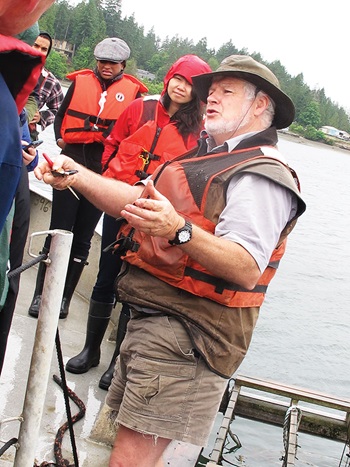 Gordon King explains mussel production to visitors at the Taylor Shellfish Farms. Totten Inlet site.
Gordon King explains mussel production to visitors at the Taylor Shellfish Farms. Totten Inlet site. New Zealander Gordon King overseas the mussel farming, which uses ropes hung from rafts. Longline ropes commonly used in other countries are vulnerable to ducks, who enjoy the mussels, he says.
Each rope is one to two metres long, and each raft is 10 metres square, capable of producing 10,000 kilograms of mussels per raft. In Totten Inlet there are 21 rafts, but the total area committed to mussel farming is almost one hectare, including a recently approved farm nearby. Annual production potential is now 1.5 million kilograms, up from 544,300 kilograms, with mussels harvested at 18 months.
Unlike mussel farming, Bill Taylor says geoduck (pronounced gooey-duck) farming was virtually unknown when they started doing it in the 1990s: “There was a lot of trial and error, and not a lot of research on the species.”
Geoducks live in the sand and bury themselves more than a metre below the surface. The clam’s distinctive siphon is extended from beneath the sand into the water to both extract nutrients from the water and to eliminate waste.
In the wild they can grow to more than six kilograms and can potentially live for more than 100 years. In commercial production, the Taylors harvest them at six years of age, when they reach 900 grams to 1 kilogram. They harvest about 272,000 kilograms of geoduck a year, which are sold live.
Environmental issues
Water quality is a crucial issue for the Taylors; their geoduck and oysters in particular are often sold live and eaten raw. As such, the Taylors and other shellfish farmers have been on the frontline of water pollution issues for almost a century.
Bill Taylor says when a pulp mill was set up at Shelton on the shores of the Puget Sound in 1929 there was no regulation of its sulfide discharges. The mill was eventually closed in the 1950s after an extended campaign from shellfish farmers.
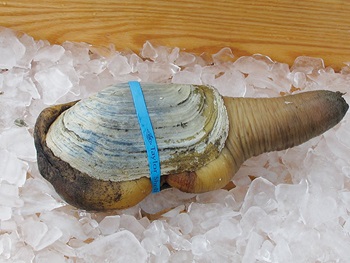 Farming geoduck (pronounced gooey duck) has been a new venture for the Taylors and for the US aquaculture industry.
Farming geoduck (pronounced gooey duck) has been a new venture for the Taylors and for the US aquaculture industry. While the US Clean Water Act 1972 helped control these kinds of discharges, non-point source pollution then become a growing issue, including agricultural run-off, contamination from animals, untreated sewage leaks and stormwater.
“We’re at the bottom of the drain, so we’ve been involved with agriculture for a long time to prevent pollution,” Bill Taylor says.
And just when they thought the water-quality issues were generally under control they found a large proportion of the oyster larvae at their Shelton hatchery was dying.
They treated the water for what they initially thought was a marine bacteria, but the larvae kept dying. They soon realised there was upwelling of high-acidity water in the Sound, and the Pacific Oysters were particularly susceptible during the first three to four days of their life. Buffering the water at the hatchery by injecting sodium carbonate has helped to increase the pH and improve survival.
But the business continues to employ a full-time research supervisor at the hatchery to oversee a range of trials including water quality and shellfish survival, breeding for improved disease and pH resilience and increasing the production of algae used to feed the larvae and spat. There are always new challenges. “And we’re always trying to improve the product,” Bill Taylor says.





